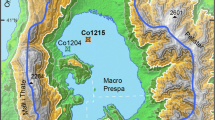Abstract.
The late-Glacial/Holocene transition in the North Atlantic-European sectors has long been known to be a period of rapid climate change. There is, however, a continued need for acquiring and developing paleoclimate archives spanning this interval from continental settings. Here we report on a lacustrine (Fayetteville Green Lake) isotope record sampled at a 10-year resolution from the NE USA over the late-Glacial/Holocene interval (14,600–8000 cal year BP). Based on prior isotopic and hydrologic research from Green Lake, the δ18O(calcite) values predominantly reflect winter moisture source and thus winter atmospheric patterns. Furthermore, we use historic (AD 1948–1980) winter circulation data and δ18O(calcite) values from varved sediments to examine the relationship between the circumpolar vortex latitude and isotopes which results in a strong (r = –0.79; r 2 = 0.63) negative relationship. Using the linear regression from the isotope-vortex relationship, we model the winter vortex latitude for the late-Glacial/Holocene transition over the NE USA. In addition, we identify an interval from 11,600 to 10,300 cal year BP (the post-Younger Dryas climate interval) wherein the mean winter vortex over the NE USA was expanded by ∼6° latitude (∼36.1°N; i.e., ∼630 km) from its mean historic position between AD 1948–1998 (∼41.8°N). Renewal of more vigorous thermohaline circulation following the Younger Dryas cold event may have forced the post-Younger Dryas climate interval. Increased poleward heat transport due to an active oceanic conveyor would have strengthened the thermal contrast between the NE USA and the North Atlantic thereby enhancing atmospheric pressure gradients and firmly establishing the semi-permanent winter trough over the NE USA. Consequently, storms tracked more frequently up the east coast of the United States from the Gulf of Mexico and Atlantic regions delivering precipitation with relatively high δ18O values to the NE USA. Alternatively, the relative dominance of seasonal precipitation may have changed resulting in less total winter precipitation (low δ18O) causing lake waters to become relatively enriched in high δ18O summer precipitation. Both hypotheses are good candidates for testing by global circulation modeling (GCM). The termination of the post-YD interval at 10,300 cal year BP and the beginning of the Holocene was likely forced by a gradual decrease in thermohaline circulation and poleward heat transport as freshwater input from melting of high-latitude ice sheets increased.
Similar content being viewed by others
Author information
Authors and Affiliations
Rights and permissions
About this article
Cite this article
Kirby, .M., Patterson, .W., Mullins, .H. et al. Post-Younger Dryas climate interval linked to circumpolar vortex variability: isotopic evidence from Fayetteville Green Lake, New York. Climate Dynamics 19, 321–330 (2002). https://doi.org/10.1007/s00382-002-0227-y
Received:
Accepted:
Issue Date:
DOI: https://doi.org/10.1007/s00382-002-0227-y




